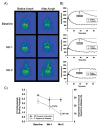Manganese: recent advances in understanding its transport and neurotoxicity
- PMID: 17466353
- PMCID: PMC1950780
- DOI: 10.1016/j.taap.2007.03.001
Manganese: recent advances in understanding its transport and neurotoxicity
Abstract
The present review is based on presentations from the meeting of the Society of Toxicology in San Diego, CA (March 2006). It addresses recent developments in the understanding of the transport of manganese (Mn) into the central nervous system (CNS), as well as brain imaging and neurocognitive studies in non-human primates aimed at improving our understanding of the mechanisms of Mn neurotoxicity. Finally, we discuss potential therapeutic modalities for treating Mn intoxication in humans.
Figures


References
-
- Aisen P, Aasa R, Redfield AG. The chromium, manganese, and cobalt complexes of transferrin. J Biol Chem. 1969;244:4628–4633. - PubMed
-
- Alves G, Thiebot J, Tracqui A, Delangre T, Guedon C, Lerebours E. Neurologic disorders due to brain manganese deposition in a jaundiced patient receiving long-term parenteral nutrition. J Parenter Enteral Nutr. 1997;21:41–45. - PubMed
-
- Archibald FS, Tyree C. Manganese poisoning and the attack of trivalent manganese upon catecholamines. Arch Biochem Biophys. 1987;256:638–650. - PubMed
-
- Aschner M, Aschner JL. Manganese transport across the blood-brain barrier: relationship to iron homeostasis. Brain Res Bull. 1990;24:857–860. - PubMed
-
- Aschner M, Erikson KM, Dorman DC. Manganese dosimetry: Species differences and implications for neurotoxicity. Crit Rev Toxicol. 2005;35:1–32. - PubMed
Publication types
MeSH terms
Substances
Grants and funding
LinkOut - more resources
Full Text Sources
Other Literature Sources
Medical

